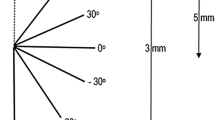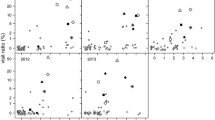Abstract
Many generalist herbivores, especially adult beetles, are facultative florivores, feeding on leaves but readily accepting floral tissues when available. We speculated that day-flying beetles with high energetic requirements would benefit from dietary mixing with nutrient-rich flower tissues and favor them during foraging. We tested that “Floral Affinity Hypothesis” with Popillia japonica, a day-active ruteline scarab that feeds intermittently throughout its adult life on multiple plant species. In field tests with six species of flowering hosts, far more landings occurred on flowers than on foliage for all plants except Hibiscus syriacus which bears flowers along the main stem rather than terminally. Trials with elevated plants showed that height of the floral display contributes to beetles’ landing on flowers. Flower petals generally were preferred over leaves in laboratory choice tests. Nitrogen and water content were comparable or higher in foliage than in petals, but plant sugars were much higher in petals. Longevity and fecundity of beetles provided single-plant diets of Hibiscus, Rosa × hybrida, or Trifolium flowers for 3 weeks were as high, or higher, than for beetles fed foliage of Tilia cordata, a highly suitable resource. As expected, rotating flowers or Tilia foliage with marginally suitable Quercus palustris foliage enhanced those parameters relative to a diet of Quercus alone, but beetles provided high-quality Tilia foliage also benefitted from dietary mixing with flowers. Nearly all past dietary mixing studies concerned immature insects, for which growth rate is paramount. Opportunistic florivory by adult beetles represents a type of dietary mixing wherein the premium may be calorie-rich food for fueling flight muscles, with ensuing reproductive benefits.

Similar content being viewed by others
References
Ahmad S (1983) Mixed-function oxidase activity in a generalist herbivore in relation to its biology, food plants, and feeding history. Ecology 64:235–243
Analytical Software (2000) Statistix for Windows v. 7.0. Analytical Software, Fla.
Bernays EA (1999) When host choice is a problem for a generalist herbivore: experiments with the whitefly, Bemisia tabaci. Ecol Entomol 24:260–267
Bernays EA, Bright KL (1993) Mechanisms of dietary mixing in grasshoppers: a review. Comp Biochem Physiol 104A:125–131
Bernays EA, Chapman RF (1994) Host-plant selection by phytophagous insects. Chapman and Hall, New York
Bernays EA, Minkenberg OPJM (1997) Insect herbivores: Different reasons for being a generalist. Ecology 78:1157–1169
Burgess KH (1991) Florivory: the ecology of flower feeding insects and their host plants. Dissertation, Harvard University
Carroll M, Hanlon A, Hanlon T, Zangerl AR, Berenbaum MR (1997) Behavioral effects of carotenoid sequestration by the parsnip webworm, Depressaria pastinacella. J Chem Ecol 23:2707–2719
Chappell MA (1984) Thermoregulation and energetics of the green fig beetles (Cotinis texana) during flight and foraging behavior. Physiol Zool 57:581–589
Clancy KM (1992) The role of sugars in western spruce budworm nutritional ecology. Ecol Entomol 17:189–197
Clausen CP, King JL, Teranishi C (1927) The parasites of Popillia japonica in Japan and chosen (Korea) and their introduction into the United States. US Dep Agric Bull 1429
Courtney SP (1982) Coevolution of pierid butterflies and their cruciferous food plants. IV. Crucifer apparency and Anthocaris cardamines (L.) oviposition, Oecologia 52:258–265
Fleming WE (1972) Biology of the Japanese beetle. US Dep Agric Bull 1383
Gibernau, M, Barabé D, Cerdan P, Dejean A (1999) Beetle pollination of Philodendron solimoesense (Araceae) in French Guiana. Int J Plant Sci 160:1135–1143
Gronquist M, Bezzeridea A, Attygale A, Meinwald J, Eisner M, Eisner T (2001) Attractive and defensive functions of the ultraviolet pigments of a flower (Hypericum calycinum). Proc Natl Acad Sci USA 98:13745–13750
Hägele BF, Rowell-Rahier M (1999) Dietary mixing in three generalist herbivores: nutrient complementation or toxin dilution. Oecologia 119:521–533
Harborne JB (1982) Introduction to ecological biochemistry. Academic, New York
Heinrich B (1996) The thermal warriors: strategies of insect survival. Harvard University Press, Cambridge
Heinrich B, McClain E (1986) “Laziness” and hypothermia as a foraging strategy in flower scarabs (Coleoptera: Scarabaeidae). Physiol Zool 59:273–282
Heinrich B, Raven P (1972) Energetics and pollination ecology. Science 176:507–602
Held DW (2003) Basic and applied aspects of flower-feeding by the Japanese beetle (Coleoptera: Scarabaeidae). Dissertation, University of Kentucky
Held DW, Potter DA (2003) Characterizing toxicity of Pelargonium spp. and two other reputedly toxic plant species to Japanese beetles (Coleoptera: Scarabaeidae). Environ Entomol 32:873–880
Held DW, Potter DA (2004) Floral characteristics affect susceptibility of hybrid tea roses, Rosa × hybrida, to Japanese beetles (Coleoptera: Scarabaeidae). J Econ Entomol 97:353–360
Kevan PG, Baker HG (1984) Insects on flowers. In: Huffaker CB, Rabb RL (eds) Ecological entomology. Wiley, New York, pp 607–631
Kirk WDJ, Ali M, Breadmore K (1995) The effects of pollen beetles on foraging behaviour of honey bees. J Apic Res 34:15–22
Kreuger B, Potter DA (2001) Diel feeding activity and thermoregulation by Japanese beetles (Coleoptera: Scarabaeidae) within host plant canopies. Environ Entomol 30:172–180
Ladd TL Jr (1986) Influence of sugars on the feeding response of Japanese beetles (Coleoptera: Scarabaeidae). J Econ Entomol 79:668–671
Ladd TL Jr (1987) Japanese beetle (Coleoptera: Scarabaeidae): influence of favored food plants on feeding response. J Econ Entomol 80:1014–1017
Loughrin JH, Potter DA, Hamilton-Kemp TR, Byers ME (1996) Role of feeding-induced plant volatiles in aggregative behavior of the Japanese beetle (Coleoptera: Scarabaeidae). Environ Entomol 25:1188–1191
Loughrin JH, Potter DA, Hamilton-Kemp TR (1998) Attraction of Japanese beetles (Coleoptera: Scarabaeidae) to host plant volatiles in field trapping experiments. Environ Entomol 27:395–400
Matter SF, Landry JB, Greco AM, Lacourse CD (1999) Importance of floral phenology and florivory for Tetraopes tetraophthalmus (Coleoptera: Cerambycidae): tests at the population and individual level. Environ Entomol 28:1044–1051
Mattson WJ, Scriber JM (1987) Nutritional ecology of insect folivores of woody plants: nitrogen, water, fiber, and mineral considerations. In: Slansky F Jr, Rodriguez JG (eds) Nutritional ecology of insects, mites, spiders, and related invertebrates. Wiley, New York, pp 105–146
McKenzie HA, Wallace HD (1954) The Kjeldahl determination of nitrogen: a critical study of digestion conditions-temperature, catalyst, and oxidizing agent. Aust J Chem 7:50–70
Metzger FW, van der Meulen PA, Mell CW (1934) The relation of the sugar content and odor of clarified extracts of plant to their susceptibility to attack by the Japanese beetle. J Agric Res 49:1001–1008
Oertli JJ, Oertli M (1990) Energetics and thermoregulation of Popillia japonica Newman (Coleoptera: Scarabaeidae) during flight and rest. Physiol Zool 63:921–937
Potter DA, Held DW (2002) Biology and management of the Japanese beetle. Annu Rev Entomol 47:175–205
Raubenheimer D, Simpson SJ (1999) Integrating nutrition: a geometrical approach. Entomol Exp Appl 91:67–82
Rowe WJ II, Potter DA (1996) Vertical stratification of feeding by Japanese beetles within linden tree canopies: selective foraging or height per se? Oecologia 108:459–466
Singer MS, Bernays EA, Carrière Y (2002) The interplay between nutrient balancing and toxin dilution in foraging by a generalist insect herbivore. Anim Behav 64:629–643
Slansky F Jr, Rodriguez JG (1987) Nutritional ecology of insects, mites, spiders, and related invertebrates. Wiley, New York
Sokal RR, Rohlf FJ (1969) Biometry. Freeman, San Francisco
Strauss SY (1997) Floral characters link herbivores, pollinators, and plant fitness. Ecology 78:1640–1645
Thompson JN (1983) The use of ephemeral plant parts on small host plants: how Depressaria leptotaeniae (Lepidoptera: Oecophoridae) feeds on Lomatium dissectum (Umbelliferae). J Anim Ecol 52:281–291
Trichilo PJ, Leigh TF (1988) Influence of resource quality on the reproductive fitness of flower thrips (Thysanoptera: Thripidae). Ann Entomol Soc Am 81:64–70
Waldbauer GP, Friedman S (1991) Self-selection of optimal diets by insects. Annu Rev Entomol 36:43–63
Acknowledgements
We thank C. Prater, M. Cummings, J. Hubbard, and M. Rogers for technical assistance. Thanks to R. Bessin, J. Buxton, K. Haynes, D. Wise (University of Kentucky) and two anonymous reviewers for suggestions that greatly improved the manuscript. Plants were donated by Bear Creek Gardens (Medford, Ore., USA) and Greenleaf Nursery (Park Hill, Okla., USA). Funding, in part, was provided through a grant from the University of Kentucky Nursery and Landscape Endowment Fund. This paper is No. 03-08-114 of the University of Kentucky Experiment Station.
Author information
Authors and Affiliations
Corresponding author
Rights and permissions
About this article
Cite this article
Held, D.W., Potter, D.A. Floral affinity and benefits of dietary mixing with flowers for a polyphagous scarab, Popillia japonica Newman. Oecologia 140, 312–320 (2004). https://doi.org/10.1007/s00442-004-1582-7
Received:
Accepted:
Published:
Issue Date:
DOI: https://doi.org/10.1007/s00442-004-1582-7




